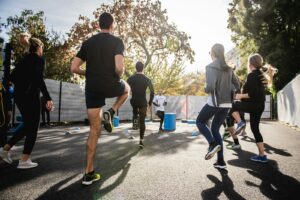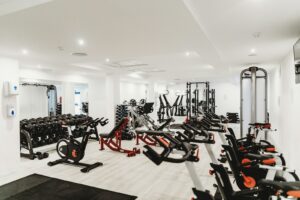Hello, it’s Sho here! Today, I’ll be talking about my least favorite topic—aerobic endurance. To improve endurance, we need to engage in aerobic training, but how exactly should we do that? I researched the best ways to approach it, and in this article, I’ll share what I found.
To perform effective aerobic training, it’s crucial to understand the difference between aerobic capacity and aerobic power. Both are connected to the aerobic energy system but focus on different elements. This article will define both terms, offer specific training methods to improve each, and explore how to use these concepts in CrossFit to become stronger.
1. What is Aerobic Capacity?
Aerobic capacity refers to the body’s ability to supply energy over a long period of time by using oxygen. This is directly related to endurance, and it plays a vital role in maintaining performance during long-duration activities, regardless of intensity. The higher your capacity, the less likely you are to experience fatigue during exercise, and the more efficiently you can use oxygen to generate energy for sustained performance.

Key Elements of Aerobic Capacity:
- Duration and Fatigue Resistance: Aerobic capacity is heavily reliant on how long you can maintain exercise without fatigue. High endurance indicates that your muscles and cardiorespiratory system can effectively process fatigue-related byproducts, such as lactate. Sustained, moderate-intensity exercises, like long-distance running or cycling, can help improve this element.
- Oxygen Delivery Efficiency: The efficiency of oxygen delivery depends on cardiorespiratory function. Oxygen is taken in through the lungs and delivered to muscles via the bloodstream. The more efficient this process, the longer you can sustain activity. This depends on factors like cardiac output (the volume of blood the heart pumps per minute) and the oxygen-carrying capacity of your blood.
- Energy Efficiency (Fat Utilization): Those with high aerobic capacity can efficiently use fat as an energy source. Fat metabolism is slower than carbohydrates but is essential for endurance activities as it conserves glycogen stores (stored energy in muscles), enabling longer performance.
- Muscular Endurance: This refers to your muscles’ ability to withstand repetitive use over extended periods without becoming fatigued. It is influenced by the type of muscle fibers you have, the density of mitochondria (which produce energy), and the blood flow to your muscles.
Training to Improve Aerobic Capacity:
- Long Slow Distance (LSD) Training and Moderate-Intensity Sustained Exercise: Engaging in long-duration, low to moderate-intensity exercises—like 45-90 minutes of continuous running, cycling, or rowing(Zone 2)—enhances fat utilization, muscle endurance, and cardiorespiratory efficiency.
- Lactate Threshold (LT) Training: By training just below the point where lactate accumulates in the muscles, you can push your lactate threshold higher. This allows you to maintain higher intensities for longer periods.

2. What is Aerobic Power?
In contrast, aerobic power measures how much oxygen your body can use to generate energy over a short period. This is often associated with VO2 max (maximal oxygen consumption), which is a key indicator of how effectively your body can use oxygen during short bursts of high-intensity exercise.
Key Elements of Aerobic Power:
- Maximal Oxygen Consumption (VO2 max): VO2 max indicates the maximum amount of oxygen your body can take in and utilize during exercise. Higher VO2 max scores mean your body can intake more oxygen and use it efficiently, enhancing endurance and performance, especially during high-intensity activities.
- Cardiac Output: The volume of blood your heart pumps in one minute affects oxygen delivery to working muscles. The greater the cardiac output, the more oxygenated blood your muscles receive, boosting performance.
- Muscle Oxygen Utilization Efficiency: Once oxygen reaches your muscles, its efficient use is crucial for energy production. This relies on mitochondrial function within muscle cells, as mitochondria are responsible for producing energy using oxygen.
- Oxygen Transport Capacity: The amount of oxygen your blood can carry depends on the levels of hemoglobin, a protein that binds oxygen in the blood. The more oxygen transported to muscles, the better your performance in high-intensity activities.
Training to Improve Aerobic Power:
- High-Intensity Interval Training (HIIT): Alternating between short bursts of high-intensity effort and rest or low-intensity recovery helps improve VO2 max. For example, performing 30 seconds of sprinting followed by 30 seconds of rest for 8-10 rounds can boost aerobic power.
- Tempo Running: Running at 70-85% of your VO2 max for a set duration strengthens your heart’s ability to deliver oxygen efficiently and increases your overall endurance.
- CrossFit or High-Intensity Functional Training (HIFT): Short, high-load exercises, such as sprinting, rowing, or heavy lifting, can effectively train your aerobic power by challenging both your muscular and cardiorespiratory systems.

3. CrossFit Training for Aerobic Capacity and Power
CrossFit excels at stimulating various energy systems with its varied WODs (Workouts of the Day). By mixing short, high-intensity workouts with moderate-intensity sustained exercises, you can effectively improve both aerobic capacity and aerobic power.
Sample CrossFit Programs:
- Aerobic Capacity Focus:
- Workout: 20-minute AMRAP (As Many Rounds As Possible) of 400m run, 20 wall ball shots, and 15 kettlebell swings.
- Objective: Improve oxygen efficiency during sustained moderate-intensity exercise to boost aerobic capacity.
- Aerobic Power Focus:
- Workout: 30 seconds of all-out sprinting (running, rowing, or biking) followed by 30 seconds of rest for 10 rounds.
- Objective: Elevate heart rate and oxygen consumption during short, intense bursts to improve VO2 max.
4. Programming Tips
To effectively develop both aerobic capacity and power, consider the following:
- Balance Your Workouts: Combine sustained moderate-intensity workouts to boost capacity with high-intensity interval sessions to enhance power.
- Recovery and Rest: High-intensity workouts require adequate recovery. Make sure to plan rest days or low-intensity recovery sessions to avoid overtraining. Related post is here, please check out!
- Variety in Training: Incorporating different modalities like running, biking, and rowing ensures overall aerobic development while preventing interference with strength training.

Conclusion
Aerobic capacity and power are both essential for improving endurance and performance. Capacity helps sustain long-duration efforts, while power is critical for short bursts of high-intensity activity. By integrating both into your CrossFit routine, you’ll achieve balanced aerobic fitness and improved overall performance. Keep experimenting with different combinations of workouts, and most importantly, enjoy the process!
Stay strong and keep pushing your limits!
Sho
